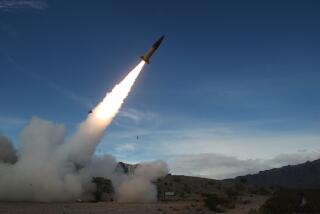Missile Defense Is Bigger Business Opportunity Than Political Controversy
- Share via
A National Missile Defense is a topic of heated debate in this year’s presidential election campaign, but it is already a major source of research on military and commercial technology and a probable big piece of future business for selected defense contractors.
The proposed system, one version of which would site 20 missiles in Alaska or North Dakota to shoot down missiles attacking the United States, is highly controversial. Critics attack it for potentially starting a new global arms race, for wasting money and for failing in several tests even to shoot down mock targets.
Yet in one way or another, the missile defense program will go forward. President Clinton in Europe last week promised to “share the technology” of missile defense with allied nations. And Russia’s new President Vladimir V. Putin, whom Clinton meets this weekend in Moscow, suggested that the United States and Russia work jointly on a missile defense system. The suggestion is not farfetched; The U.S. Defense Department and the Russian military already conduct joint satellite observation systems.
The debate on missile defense is no longer about whether to create a system, but what kind of program will work best. The idea itself, dating to the Strategic Defense Initiative, or “Star Wars,” program of President Reagan, is hardly new.
In fact, since the mid-1980s, the Pentagon and major contractors have spent about $50 billion on research and development on the lasers, infrared sensors, space-borne communications and other systems that make missile defense feasible, as well as on such programs as the Patriot missile, which won plaudits in the 1991 Gulf War for shooting down Iraqi Scud missiles.
The defense budget for fiscal year 2001, which begins in October, allocates $4.5 billion for missile defense research, up from $3.8 billion for the current fiscal year. And if the U.S. decides to go full steam ahead and deploy an antimissile system, it will launch a program that ultimately will cost more than $60 billion.
Clinton is supposed to make a decision on deployment by this fall, depending on the success of a new antimissile test in July. There could well be slippage in that schedule.
But delays and debates notwithstanding, a broad new international missile defense effort is underway. The Pentagon already has a cooperative program with Israel, which successfully tested an antimissile last November.
What is underway in practical terms is a new branch of the defense industry, led by four major firms: Boeing, the prime contractor on the National Missile Defense program; Raytheon, producer of the Patriot missile, which is being updated in new versions, and advanced radars and warheads for the antimissile program; TRW, the developer of sophisticated electronics, communications, laser and sensor technologies for missile defense; and Lockheed Martin, producer of rockets for the missile defense program and high altitude battlefield missiles for the shorter-range work of protecting U.S. troops or areas of up to 60 square miles.
Important subcontractors in Southern California include Van Nuys-based XonTech, Logicon, the San Pedro-based subsidiary of Northrop Grumman, Wyle Laboratories of El Segundo and Irvine Sensors of Costa Mesa.
For more than a decade those contractors have been at work trying to devise sensors that can “see” a missile taking off and weaponry that can react instantly to hit the offending missile before it is far out of its silo. Or, failing an early hit, they’ve been trying to develop a missile that can hit the offending missile as it hurtles toward its target--a task akin to hitting a baseball thrown at supersonic speed.
And although researchers haven’t yet come up with a missile that can “hit the baseball” every time, they have made great strides in the technologies of military surveillance and communications.
The research has produced commercial applications, such as the rapid semiconductors developed by TRW that now form the heart of wireless telephones the world over or the lasers that allow extreme lithography to make more powerful microchips.
On a less profound level, perhaps, solid fuel propulsion systems for battlefield rockets led to similar propulsion for car air bags, and infrared sensors for spotting missile silos now let drivers see beyond the headlights to pick up deer and other objects on darkened roads.
But why now? Why is there a push for a missile defense program at this time? Because it’s no longer the simple world of the Cold War in which the United States and the Soviet Union were the only combatants who could launch missiles and nuclear weaponry.
When North Korea fired a long-range missile across Japan in 1998, it was a wake-up call to U.S. defense experts to think about nearby Alaska--and to Japanese defense experts to think about new realities in Asia.
It’s significant that Israel, which came under missile attack from a neighboring nation in 1991, has made the fastest strides in developing an antimissile program.
The years to come will see greater proliferation of missiles, and perhaps wars, between nations in Asia and other continents. And the United States will have even less control than it had in the past over other nations’ policies.
That’s why the idea of missile defense will have growing appeal, not only for the U.S. but for the countries of Asia and Europe, including Russia.
Still there will be a great debate, this election year and after. Some critics see missile defense as expensive and irrelevant. “It looks only at a missile threat, when a terrorist with a suitcase is the real danger,” says Jon Kutler of Los Angeles’ Quarterdeck Investment Partners.
Robert Paulson, head of Aerostar Capital, predicts that the Air Force and Navy will try to derail missile defense because it will drain funds from the production of planes and ships.
But the real prospect is that political debates will turn to practical arguments over whether naval ships or land bases are best for antimissiles. A missile defense program will go forward, concludes Loren Thompson, director of the Lexington Institute, an Arlington, Va., research firm.
Alert defense contractors understand that. That’s why Boeing, the leading commercial airplane maker, chose in recent years to acquire the space and communications business of Rockwell and the military business of McDonnell Douglas. And it’s why Raytheon, which acquired the defense electronics business of Hughes Aircraft, is now selling its small commercial plane operations to concentrate on defense.
The contractors don’t need infrared sensors to see a lot of business ahead.
*
James Flanigan can be reached at [email protected].
(BEGIN TEXT OF INFOBOX / INFOGRAPHIC)
More Defense
Missile defense is a collective term for research and missile development programs on which the Pentagon and military contractors are now increasing expenditure to new levels, after a decade and a half of outlays totaling $50 billion
More to Read
Sign up for Essential California
The most important California stories and recommendations in your inbox every morning.
You may occasionally receive promotional content from the Los Angeles Times.










